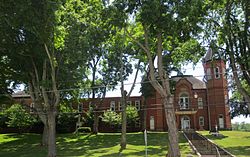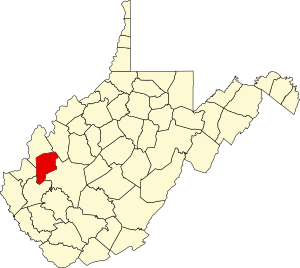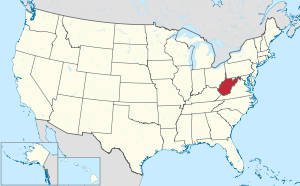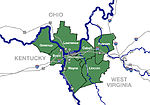Putnam County, West Virginia
Putnam County | |
|---|---|
 Putnam County Courthouse in Winfield | |
 Location within the U.S. state of West Virginia | |
 West Virginia's location within the U.S. | |
| Coordinates: 38°31′N 81°55′W / 38.51°N 81.91°W | |
| Country | |
| State | |
| Founded | March 11, 1848 |
| Named for | Israel Putnam |
| Seat | Winfield |
| Largest city | Hurricane |
| Area | |
• Total | 350 sq mi (900 km2) |
| • Land | 346 sq mi (900 km2) |
| • Water | 4.7 sq mi (12 km2) 1.3% |
| Population (2020) | |
• Total | 57,440 |
• Estimate (2021) | 57,260 |
| • Density | 160/sq mi (63/km2) |
| Time zone | UTC−5 (Eastern) |
| • Summer (DST) | UTC−4 (EDT) |
| Congressional district | 2nd |
| Website | putnamcountywv |
Putnam County is a county in the U.S. state of West Virginia. As of the 2020 census, the population was 57,440.[1] Its county seat is Winfield, its largest incorporated city is Hurricane, and its largest community is the census-designated place of Teays Valley.[2] Putnam County is part of the Huntington–Ashland, WV-KY-OH Metropolitan Statistical Area, across the Kanawha River from Charleston, West Virginia.
History
[edit]The Virginia General Assembly formed Putnam County on March 11, 1848, from parts of Cabell, Kanawha and Mason counties. It was named for Israel Putnam, who was a hero in the French and Indian War and a general in the American Revolutionary War. George Washington surveyed the area in 1770. Winfield, the county seat, had been founded in 1818 but was incorporated on February 21, 1868, and named to honor General Winfield Scott a General during the Mexican American War and early stage of the Civil War.[3]
Slavery was a divisive issue in Putnam County before and during the Civil War. In the Virginia Secession Convention of 1861, Putnam County voters elected James W. Hoge to represent them, and he voted against secession on April 17, 1861, when the convention passed the secession ordinance. However, he returned to Richmond for the second session in June, and signed the ordinance.[4] No one from Putnam county attended the Wheeling Convention which ultimately led to the creation of the state of West Virginia in 1863.
Two minor battles were fought in Putnam County during the Civil War. On July 17, 1861, Confederate soldiers defeated a Union force at the Battle of Scary Creek, before withdrawing to Charleston. The Confederates included a cavalry troop raised by Colonel Albert Gallatin Jenkins, who until Virginia's secession from the Union had represented the area in Congress. Jenkins would be commissioned a brigadier general in 1862, but died of wounds received at the Battle of Cloyd's Mountain in May 1864. The second skirmish occurred on October 24, 1864, after West Virginia became a Union state. Confederate troops seized and sank a Union steamboat on the Kanawha River near Winfield, then attacked the courthouse, but the "Battle of Winfield" ended as a Union victory.[5] Putnam County's Civil War soldiers were about evenly split between Union and Confederate, with about four hundred on each side.[6]
Putnam County was one of fifty Virginia counties admitted to the Union as the state of West Virginia on June 20, 1863. Later that year, its counties were divided into civil townships, with the intention of encouraging local government. This proved impractical in the heavily rural state, and in 1872 the townships were converted into magisterial districts.[7] Putnam County was initially divided into six townships: Buffalo, Curry, Grant, Hutton, Scott, and Union. These became magisterial districts in 1872, and the following year two were renamed, with Grant becoming Teays Valley, while Hutton became Pocatalico. Except for minor adjustments, these districts were largely unchanged until the 1980s, when Buffalo and Union Districts were consolidated into Buffalo-Union District, and Teays Valley's name abbreviated to "Teays".[8]
A railroad was rebuilt through Putnam County in 1875.
Geography
[edit]The Kanawha River flows north-northwestward through the center of Putnam County. The county terrain consists of wooded hills, carved with drainages.[9] The terrain slopes to the north, with the highest point near its SW corner at 1,129 ft (344 m) ASL.[10] The county has a total area of 350 square miles (910 km2), of which 346 square miles (900 km2) is land and 4.7 square miles (12 km2) (1.3%) is water.[11]
Major highways
[edit]Adjacent counties
[edit]- Mason County - north
- Jackson County - northeast
- Kanawha County - east
- Lincoln County - south
- Cabell County - west
Demographics
[edit]| Census | Pop. | Note | %± |
|---|---|---|---|
| 1850 | 5,335 | — | |
| 1860 | 6,301 | 18.1% | |
| 1870 | 7,794 | 23.7% | |
| 1880 | 11,375 | 45.9% | |
| 1890 | 14,342 | 26.1% | |
| 1900 | 17,330 | 20.8% | |
| 1910 | 18,587 | 7.3% | |
| 1920 | 17,531 | −5.7% | |
| 1930 | 16,737 | −4.5% | |
| 1940 | 19,511 | 16.6% | |
| 1950 | 21,021 | 7.7% | |
| 1960 | 23,561 | 12.1% | |
| 1970 | 27,625 | 17.2% | |
| 1980 | 38,181 | 38.2% | |
| 1990 | 42,835 | 12.2% | |
| 2000 | 51,589 | 20.4% | |
| 2010 | 55,486 | 7.6% | |
| 2020 | 57,440 | 3.5% | |
| 2021 (est.) | 57,260 | [12] | −0.3% |
| U.S. Decennial Census[13] 1790–1960[14] 1900–1990[15] 1990–2000[16] 2010–2020[1] | |||
2000 census
[edit]As of the census of 2000, there were 51,589 people, 20,028 households, and 15,281 families in the county. The population density was 149 people per square mile (58 people/km2). There were 21,621 housing units at an average density of 62.5 units per square mile (24.1 units/km2). The racial makeup of the county was 97.97% White, 0.56% Black or African American, 0.16% Native American, 0.58% Asian, 0.02% Pacific Islander, 0.13% from other races, and 0.59% from two or more races. 0.51% of the population were Hispanics or Latinos of any race.
There were 20,028 households, out of which 35.40% had children under the age of 18 living with them, 64.20% were married couples living together, 8.90% had a female householder with no husband present, and 23.70% were non-families. 20.60% of all households were made up of individuals, and 7.90% had someone living alone who was 65 years of age or older. The average household size was 2.56 and the average family size was 2.96.
The county population contained 25.00% under the age of 18, 7.60% from 18 to 24, 30.40% from 25 to 44, 25.50% from 45 to 64, and 11.60% who were 65 years of age or older. The median age was 38 years. For every 100 females there were 96.70 males. For every 100 females age 18 and over, there were 93.50 males.
The median income for a household in the county was $41,892, and the median income for a family was $48,674. Males had a median income of $40,782 versus $23,532 for females. The per capita income for the county was $20,471. About 7.10% of families and 9.30% of the population were below the poverty line, including 11.30% of those under age 18 and 7.60% of those age 65 or over.
2010 census
[edit]As of the census of 2010, there were 55,486 people, 21,981 households, and 16,176 families in the county.[17] The population density was 160 people per square mile (62 people/km2). There were 23,438 housing units at an average density of 67.7 units per square mile (26.1 units/km2).[18] The racial makeup of the county was 96.8% white, 0.9% black or African American, 0.7% Asian, 0.2% American Indian, 0.3% from other races, and 1.1% from two or more races. Those of Hispanic or Latino origin made up 0.9% of the population.[17] In terms of ancestry, 13.2% were American, 12.9% were German, 11.3% were English, and 10.6% were Irish.[19]
Of the 21,981 households, 33.6% had children under the age of 18 living with them, 59.6% were married couples living together, 9.5% had a female householder with no husband present, 26.4% were non-families, and 22.3% of all households were made up of individuals. The average household size was 2.51 and the average family size was 2.93. The median age was 40.9 years.[17]
The median income for a household in the county was $52,618 and the median income for a family was $63,642. Males had a median income of $51,837 versus $31,198 for females. The per capita income for the county was $25,857. About 8.5% of families and 10.4% of the population were below the poverty line, including 15.6% of those under age 18 and 6.5% of those age 65 or over.[20]
Politics
[edit]Putnam County voters have traditionally voted Republican. In only one national election since 1964 has the county selected the Democratic candidate.
| Year | Republican | Democratic | Third party(ies) | |||
|---|---|---|---|---|---|---|
| No. | % | No. | % | No. | % | |
| 2024 | 19,868 | 72.23% | 7,124 | 25.90% | 515 | 1.87% |
| 2020 | 20,034 | 70.29% | 7,878 | 27.64% | 589 | 2.07% |
| 2016 | 17,788 | 70.56% | 5,884 | 23.34% | 1,539 | 6.10% |
| 2012 | 16,032 | 67.47% | 7,256 | 30.54% | 472 | 1.99% |
| 2008 | 15,162 | 60.92% | 9,334 | 37.51% | 391 | 1.57% |
| 2004 | 15,716 | 62.49% | 9,301 | 36.98% | 134 | 0.53% |
| 2000 | 12,173 | 59.60% | 7,891 | 38.63% | 362 | 1.77% |
| 1996 | 8,803 | 46.80% | 8,029 | 42.69% | 1,977 | 10.51% |
| 1992 | 7,653 | 43.91% | 6,817 | 39.12% | 2,958 | 16.97% |
| 1988 | 8,163 | 55.00% | 6,640 | 44.74% | 38 | 0.26% |
| 1984 | 9,238 | 63.75% | 5,208 | 35.94% | 46 | 0.32% |
| 1980 | 7,561 | 51.48% | 6,409 | 43.64% | 716 | 4.88% |
| 1976 | 6,334 | 43.50% | 8,226 | 56.50% | 0 | 0.00% |
| 1972 | 8,265 | 63.40% | 4,771 | 36.60% | 0 | 0.00% |
| 1968 | 5,252 | 45.27% | 5,009 | 43.18% | 1,340 | 11.55% |
| 1964 | 4,165 | 37.61% | 6,910 | 62.39% | 0 | 0.00% |
| 1960 | 5,702 | 53.44% | 4,968 | 46.56% | 0 | 0.00% |
| 1956 | 5,560 | 53.91% | 4,754 | 46.09% | 0 | 0.00% |
| 1952 | 4,944 | 50.73% | 4,802 | 49.27% | 0 | 0.00% |
| 1948 | 3,722 | 45.59% | 4,426 | 54.21% | 16 | 0.20% |
| 1944 | 4,025 | 50.67% | 3,918 | 49.33% | 0 | 0.00% |
| 1940 | 4,268 | 46.61% | 4,888 | 53.39% | 0 | 0.00% |
| 1936 | 3,938 | 45.16% | 4,756 | 54.54% | 26 | 0.30% |
| 1932 | 3,411 | 44.94% | 4,098 | 53.99% | 81 | 1.07% |
| 1928 | 3,346 | 57.76% | 2,406 | 41.53% | 41 | 0.71% |
| 1924 | 2,862 | 46.74% | 2,946 | 48.11% | 315 | 5.14% |
| 1920 | 3,223 | 54.49% | 2,578 | 43.58% | 114 | 1.93% |
| 1916 | 1,925 | 49.45% | 1,837 | 47.19% | 131 | 3.37% |
| 1912 | 531 | 13.98% | 1,540 | 40.55% | 1,727 | 45.47% |
Notable people
[edit]- Michael Barber - a former American football wide receiver who played college football at Marshall University. He was inducted into the College Football Hall of Fame in 2005. Drafted in the 4th round (pick 112) by the San Francisco 49ers, he went on to play 4 seasons in the NFL. Inducted into the West Virginia Sports Hall of Fame in 2020.
- Frank Clayton Bowyer - was an American businessman who served as mayor of Tampa, Florida from June 1898 to June 1900. He was a Democrat.
- Virginia Mae Brown- was a civil servant, government official, and lawyer. She was West Virginia's first female assistant attorney general. She was later the first female to hold the position of West Virginia's insurance commissioner. President Lyndon B. Johnson appointed Brown a member of the Interstate Commerce Commission (ICC), the first female since its inception in 1887, and later promoted her to be its first female chair.
- Samuel Simon Gordon - was an American Negro league first baseman between 1908 and 1913.
- Eugene H. Comstock - was a NASCAR Grand National Series driver from Chesapeake, Ohio, USA.
- Kathryn "Kathie" Hess Crouse - an American politician and activist serving as a member of the West Virginia House of Delegates from the 13th district. She was appointed by Governor Jim Justice on December 2, 2021.
- Minnie Buckingham Harper - was an American politician and housewife. In 1928 she became the first black woman legislator in the United States.
- Samantha Jane Atkeson Morgan -was a painter
- Brady Ralph Paxton- is a politician and a Democratic member of the West Virginia House of Delegates representing District 13 since his April 22, 1999, appointment to fill the vacancy caused by the resignation of Representative Gary Tillis. Paxton served non-consecutively from January 1993 until January 1995.
- Eric J. Tarr - is a Republican member of the West Virginia Senate, representing the 4th district since January 9, 2019.
Communities
[edit]Cities
[edit]Towns
[edit]Magisterial districts
[edit]- Buffalo-Union
- Curry
- Pocatalico
- Scott
- Teays
Census-designated places
[edit]- Culloden (part)
- Hometown
- Teays Valley
Unincorporated communities
[edit]See also
[edit]- Amherst-Plymouth Wildlife Management Area
- National Register of Historic Places listings in Putnam County, West Virginia
References
[edit]- ^ a b "State & County QuickFacts". United States Census Bureau. Retrieved August 14, 2022.
- ^ "Find a County". National Association of Counties. Retrieved June 7, 2011.
- ^ "History of Putnam County, WV". www.wvgenweb.org. Retrieved October 27, 2020.
- ^ How Virginia Convention Delegates Voted on Secession, April 4 and April 17, 1861, and Whether They Signed a Copy of the Ordinance of Secession
- ^ Steelhammer, Rick. "Confederate troops fought, died to take Winfield 150 years ago today". Charleston Gazette-Mail. Retrieved October 27, 2020.
- ^ Sullivan, Ken (ed.), The West Virginia Encyclopedia, The West Virginia Humanities Council,2006, pg. 592, ISBN 0-9778498-0-5
- ^ Otis K. Rice & Stephen W. Brown, West Virginia: A History, 2nd ed., University Press of Kentucky, Lexington (1993), p. 240.
- ^ United States Census Bureau, U.S. Decennial Census, Tables of Minor Civil Divisions in West Virginia, 1870–2010.
- ^ Putnam County WV Google Maps (accessed March 20, 2019)
- ^ ""Find an Altitude/Putnam County WV" Google Maps (accessed March 20, 2019)". Archived from the original on May 21, 2019. Retrieved March 20, 2019.
- ^ "2010 Census Gazetteer Files". United States Census Bureau. August 22, 2012. Retrieved July 30, 2015.
- ^ "Annual Estimates of the Resident Population for Counties: April 1, 2020 to July 1, 2021". Retrieved August 14, 2022.
- ^ "U.S. Decennial Census". United States Census Bureau. Retrieved January 11, 2014.
- ^ "Historical Census Browser". University of Virginia Library. Retrieved January 11, 2014.
- ^ "Population of Counties by Decennial Census: 1900 to 1990". United States Census Bureau. Retrieved January 11, 2014.
- ^ "Census 2000 PHC-T-4. Ranking Tables for Counties: 1990 and 2000" (PDF). US Census Bureau. Retrieved January 11, 2014.
- ^ a b c "Profile of General Population and Housing Characteristics: 2010 Demographic Profile Data". US Census Bureau. Archived from the original on February 13, 2020. Retrieved April 3, 2016.
- ^ "Population, Housing Units, Area, and Density: 2010 - County". US Census Bureau. Archived from the original on February 13, 2020. Retrieved April 3, 2016.
- ^ "Selected Social Characteristics in the US – 2006-2010 American Community Survey 5-Year Estimates". US Census Bureau. Archived from the original on February 13, 2020. Retrieved April 3, 2016.
- ^ "Selected Economic Characteristics – 2006-2010 American Community Survey 5-Year Estimates". United States Census Bureau. Archived from the original on February 13, 2020. Retrieved April 3, 2016.
- ^ Leip, David. "Atlas of US Presidential Elections". uselectionatlas.org. Retrieved March 28, 2018.


